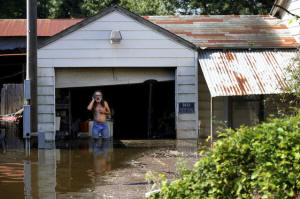|
Hurricane Harvey will be a big test for
FEMA
 Send a link to a friend
Send a link to a friend
 [September 01, 2017]
By Valerie Volcovici and Brian Thevenot [September 01, 2017]
By Valerie Volcovici and Brian Thevenot
WASHINGTON/HOUSTON (Reuters) - Nearly a
week after Hurricane Harvey swamped her home in northeast Houston, Mimi
Wilson is pondering how to start a new life with nothing - no house, no
car and no paycheck after missing work.
She has applied for assistance from the Federal Emergency Management
Agency. Her priority: moving her two young daughters out of the shelter
at Houston's convention center.
“We’re just waiting on our hotel voucher,” she said. “I need to make a
home for my children.”
FEMA's response to tens of thousands of storm victims such as Wilson
will be closely watched as the agency continues to repair an image badly
damaged more than a decade ago in the aftermath of Hurricane Katrina.
The agency was accused of being slow to respond to victims in New
Orleans and bungling delivery of basic services such as housing.
Congressional reforms followed and further changes were made after Super
Storm Sandy in 2012. Some say the improvement is noticeable.

"We found that FEMA has made a ton of progress since Katrina and Sandy,"
said Chris Currie, director of emergency management and national
preparedness issues at the Government Accountability Office, an
independent, nonpartisan government watchdog agency.
"If you look back at Katrina, FEMA's role was much more reactionary. In
this case (Harvey), they have been able to pre-deploy assets before the
full disaster strikes."
As of Thursday afternoon, more than 96,000 individuals and households
had been approved for FEMA assistance with more than $57-million dollars
already provided to individuals and households, a FEMA spokesperson
said.
Of that amount, $9.5-million-dollars had been approved for housing
assistance for victims, mainly for help with rent of up to $2,000 a
month. Victims are also eligible for a one-time payout of $500 to cover
"critical needs" such as diapers, infant formula, food and fuel.
FEMA makes emergency grants available as soon as a hurricane or other
catastrophe is declared a disaster by the U.S. president. The agency can
offer as much as $30,000 per household, but most payments are much
smaller.
The average payout to Hurricane Katrina victims was $7,114. For Sandy it
was $8,016. Those sums might seem modest for victims who have lost
everything. But the aid is intended to be temporary, said Rafael
Lemaitre, former public affairs director for FEMA until January 2017.
The grants "are not designed to make lives whole again. It's a life
vest. It is designed to help the most vulnerable get back on their
feet," he said.

Lemaitre said one of the big changes since Katrina is that FEMA is more
pro-active in getting help to people faster. Victims can sign up online
via FEMA’s new app. The agency also sends teams out into shelters to
register people on the spot.
Oversight has also been toughened to combat abuses, according to Currie
of the GAO. He said around 20 percent of Katrina payouts were lost to
fraud and abuse, a rate that was lowered to the 2 percent to 6 percent
range with Sandy.
"A lot of it has to do with technology; you apply on-line, or with a
mobile phone," Currie said. "There is more technology available to make
sure the money is going to the right people and verify who it is
supposed to go to."

to top of second column] |

Kent Kirk looks out from his garage flooded by Tropical Storm Harvey
in Rose City, Texas, U.S. on August 31, 2017. REUTERS/Jonathan
Bachman

Some Harvey victims say this heightened scrutiny is making their
shattered lives even more difficult.
At the Houston convention center shelter, a 59-year-old man who
would only give his first name, Tyrone, said FEMA has denied him
assistance because he does not own the flooded home where he lives;
it is still in the name of his mother, who died 18 months ago.
Tyrone said he could not retitle it in his name because his mother
left the house to all six of her children. He can't see any other
solution than to live in a flood-damaged dwelling.
“I’m in some kind of bind,” he said. “I don’t think it’s fair."
Houston resident Jesse Salas had better luck. He had come to the
convention center specifically to apply for FEMA assistance. His
home didn’t flood, but a power surge in his neighborhood had
destroyed all his appliances, he said, and he had lost a week's
employment as a construction worker.
Salas said representatives from FEMA told him he would be
compensated for both losses after an inspector came to his home to
confirm the appliances were broken.
FEMA also offers victims low-interest loans from the Small Business
Administration for up to $250,000 to repair or rebuild dwellings and
$100,000 for property damage.
Currie said Harvey will be the first major trial for changes made to
quicken response times.

"Harvey is going to be a test of the capacity of the program and the
speed," he said.
More challenges for the agency are ahead.
Paul Rosenzweig, former deputy secretary of the Department of
Homeland Security , said a critical juncture will be four or so
weeks from now when the focus turns from short-term aid to long term
assistance.
“In the next four weeks there are people who are going to be
homeless forever. The real thing that went wrong in Katrina was not
being well prepared for that," he said. "Harvey is going to create a
bigger problem. There will be more people dislocated for longer
periods of time and it cannot become be a long term federal
responsibility.”
(Reporting By Valerie Volcovici in Washington and Brian Thevenot in
Houston; Editing by Marla Dickerson)
[© 2017 Thomson Reuters. All rights
reserved.]
Copyright 2017 Reuters. All rights reserved. This material may not be published,
broadcast, rewritten or redistributed.
 |